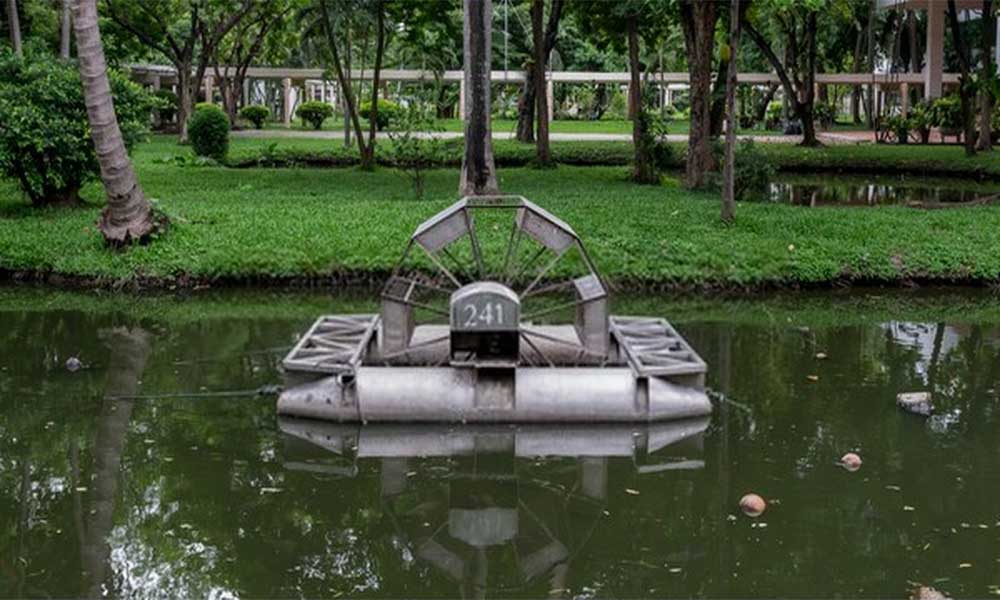Winter’s icy grip can transform your tranquil pond into a frozen wasteland. But fear not! With a few ingenious strategies, you can keep your pond from freezing without resorting to electricity. Embark on this journey of protecting your aquatic paradise and ensuring the well-being of your beloved finned companions.

Image: www.waterheaterhub.com
1. Aeration: The Fountain of Life
Aeration is to your pond what oxygen is to you. By introducing oxygen into the water, you create a life-giving bubble that prevents its surface from freezing. Install a bubbler or aerator to create a constant stream of oxygen-rich water, keeping a hole open in the ice and allowing toxic gases to escape. This simple yet effective measure is crucial for maintaining the health of your pond’s inhabitants.
2. Natural Insulation: Nature’s Blanket
Nature has its own ingenious ways of protecting water bodies from freezing. Mimic these natural processes by adding natural insulators to your pond. Floating pond covers, made of durable materials like Styrofoam, provide an effective barrier between the cold air and the water. Hay or straw bales, when placed around the pond’s edge, create an insulating layer that reduces heat loss. You can also add vegetation to the pond’s perimeter, as plants serve as windbreaks and further insulate the water.
3. Water Depth: A Deeper Sanctuary
Deeper water is less susceptible to freezing compared to shallow water. Ponds with a depth of two feet or more are less likely to freeze completely. If feasible, deepen your pond to provide a haven for your fish and other aquatic creatures during the harsh winter months.

Image: lovefishtank.com
4. Floating Deicers: A Clear Solution
Floating deicers are game-changers in the battle against freezing. These devices circulate warm water from deeper, ice-free areas to the surface, preventing ice formation. As they float on the water’s surface, they create a barrier that keeps newly melted water from refreezing. This method is both efficient and environmentally friendly, ensuring an oasis for your pond’s inhabitants.
5. Heaters: A Warm Embrace
When natural methods fall short, supplemental heat becomes necessary. Submersible pond heaters, specifically designed to withstand the rigors of aquatic environments, can be deployed to maintain a safe temperature for your fish and other pond life. Choose the appropriate heater size based on the pond’s volume and ensure proper placement for optimal effectiveness.
6. Partial Freezing: Embrace the Ice
Partially freezing your pond can be a viable strategy in certain situations. Allow the shallow areas of the pond to freeze, while keeping a larger section open for aeration and access. This creates a gradient of temperatures, allowing fish to seek refuge in the warmer, deeper areas. This method can be particularly beneficial for ponds with large fish populations or those located in regions with mild winters.
7. Chemical Solutions: A Last Resort
Chemical deicers, such as calcium chloride or potassium chloride, can be used to melt ice and prevent freezing. However, these chemicals can be harmful to aquatic life and the environment. Use them sparingly and only as a last resort. Carefully follow the instructions and dosage rates to minimize any potential negative impacts.
8. Emergency Measures: Quick Fixes
When time is of the essence, emergency measures become imperative. In the event of a sudden freeze, break the ice using a wooden pole or broom handle. Be cautious not to damage the pond liner or injure any fish. Avoid using salt or boiling water, as these can have harmful effects on aquatic life. Instead, consider using warm pond water to melt a hole in the ice.
How To Keep A Pond From Freezing Without Electricity
Conclusion: A Symphony of Solutions
Preventing your pond from freezing without electricity requires a symphony of solutions that work together harmoniously. By understanding the science behind ice formation and employing the strategies discussed, you can protect your aquatic paradise and ensure the safety and well-being of its inhabitants. Remember to tailor your approach to your specific pond’s characteristics and climate conditions. With a bit of planning and care, you can keep your pond thriving throughout the winter, providing a tranquil sanctuary for both you and your aquatic companions.